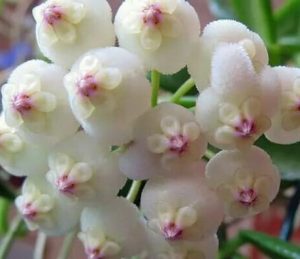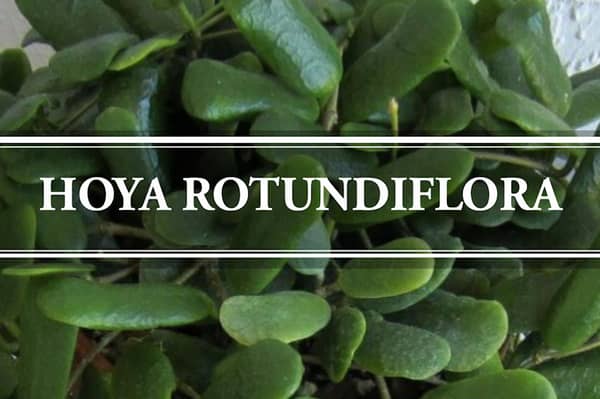Are you looking for a low-maintenance Hoya vine with fuzzy little leaves? Let us introduce you to the Hoya rotundiflora plant. This Thailand native tropical climber can get about 2 meters long on maturity. Small, dark-green and semi-succulent leaves grow along the thin dangling stems of the vine. Numerous clusters of tiny white flowers enhance the beauty of the plant in spring and summer.
Moreover, you are going to love the serene sweetish scent of these flowers, especially in the early hours of the evening. Interesting? This fast-growing vine requires minimal maintenance and is suitable for both indoor and outdoor plantations. Pots, containers, hanging baskets, or land, you can grow it anywhere you like. Still with us? Let us learn more about the care and propagation of the cute looking epiphytic climber, the Rotundiflora Hoya Plant.
Hoya Rotundiflora Classification
Family: Apocynaceae (The Dogbane Family)
Genus: Hoya.
Species: H. rotundiflora.
Genus Hoya:
Robert Brown, a popular botanist officially introduced the genus and named it in the memory of Thomas Hoy. Hoya constitutes about 700 evergreen flowering plants. Moreover, new species and cultivars are continuously being discovered and added.
These plants are famous for their thick waxy leaves. Besides, clusters of beautiful tiny and scented flowers bloom in the warm season. The majority of these are epiphytic climbers. ‘Wax flowers Plant’, ‘Wax vine’ and ‘Porcelain Flower plant’ are the common names for the members of this genus.
Features of the Hoya Rotundiflora Plant

Size:
- The thin dangling vines can get about 2 meters long on maturity.
Leaves:
- Numerous rectangular-shaped small leaves grow in an alternate pattern along the vine stems.
- Each mature leaf is about 3 to 6 cm in length.
Flower:
- The plant will adorn your surroundings with sweetly scented flowers in spring and summer. The early hours of the evening are perfect to enjoy the peak of their mesmerizing fragrance.
- Numerous tiny star-shaped flowers grow to form clusters of about 15 cm in size. Each flower is white with a yellowish centre. Moreover, you may notice tiny hair-like growth on these flowers giving them a specific velvety texture.
- These flowers grow from the specific flowering structures known as ‘spurs’. These spurs are responsible for the flower growth in each season. So, make sure you don’t remove them.
Aerial Roots:
These creepers have tiny aerial roots growing throughout the stems of the vines. At every 2 inches, you will find a greyish or pale-yellow tiny root. These roots help the vine to climb upon the support.
Toxicity:
The plants come with the inherited toxicity of the milk-weed family. The milky white latex running inside the plant body causes allergic reactions to being touched and ingested.
Where to Grow:
These Hoyas are excellent for making hanging baskets. You can use them for both indoor and outdoor plantations.
Hoya Rotundiflora Care
Feel free to get this rectangular-leafed vine for your indoor and outdoor plantation. Perfect for beginners and lazy peeps, this creeper is good to go with the simple ‘Hoya plant Care’.
Quick Guide:
Water: Average (Soak the soil and let it dry out between consecutive waterings).
Sunlight: The bright indirect sun.
Humidity: Prefers high humidity but tolerance for low range.
Fertilizer: low monthly dosages in spring and summer.
Without any further discussion, let us get a deeper understanding of the care and growing requirements of the Rotundiflora plant.
Water Requirement
The Hoya rotundiflora plant likes to stand in moist soil and need frequent watering. Just water the soil thoroughly to soak and wait for the upper layer to lose moisture before watering again. You can check the moisture level by simply touching the upper soil. Water right after the soil feels dry to touch.
Different factors affect the water requirement of the plant. These factors include sunlight, temperature, and humidity. Once you understand the drying pattern of soil, it will be easy to develop a watering schedule.
You may need to water the plant once to thrice a week in summer. On the other hand, low temperature makes the soil take longer to get dry. Moreover, it reduces the water consumption of the soil as well. So, once every fourteen days are enough to keep the plant alive in fall and winter.
Over-watering is always harmful to the majority of Plants. Wet soil suppresses the oxygen availability for the roots leading to issues like fungus and root rot. Yellowing of leaves is the first possible sign of the plant being over-watered.
Sunlight Requirement
The bright indirect sun is ideal to keep the Rotundiflora Vine happy. It can tolerate a few hours of direct sun in the early morning or late afternoon. However, the direct sun of peak hours can scorch out the delicate foliage.
Temperature Requirement
The ideal temperature range for the majority of the Hoyas is between 50 to 80°F. These plants have poor tolerance for severe temperatures. They can withstand a slightly colder temperature around 35°F. However, frost can freeze and kill the plant. So, people of cooler regions should place the plant indoors in some warm spot right before autumn arrives.
Humidity Requirement
These moisture-loving tropical plants would love to stay at a moisture level of 70% and above. However, the plants can tolerate a range of humidity levels unless it gets very dry.
In cold and dry days of fall and winter, you need to compensate for the moisture loss. You can use different measures like grouping the plants or using a pebble-water tray under the pot. Using a room humidifier is another possibility. Moreover, you can move the plant to comparatively higher humid areas of the house like bathrooms.
Misting is another popular method to enhance the moisture level of the foliage. You can mist the foliage lightly but make sure it stays at a well-ventilated place. Keeping the foliage wet for longer hours can attract issues like fungus, rotting, and pest attacks. Besides, avoid misting the flowers.
Soil Requirement
Rich and well-drained soils are ideal for Hoyas. Growing mixtures with large particles are suitable for these plants.
Fertilizer Requirements
Adding some mild fertilizer shows good results for the growth rate and appearance of the plant. Use a common good quality houseplant fertilizer once a month in spring and summer. Howbeit, the nutrition consumption of the plants decreases with low temperature. So, avoid fertilizing right before the final days of summer.
Pot Requirements
These vines make nice hanging baskets for both indoor and outdoor plantations. Moreover, you can get these for containers and pots of all sizes. Just make sure there are drainage holes at the base. Also, the vine needs a supporting pole to climb upon while growing in pots and containers. You can use a sphagnum moss pole to support the creeper.
Use fresh growing mixture with large particles and repot the vine every alternate year.
Pruning Requirements
Older and unhealthy leaves need to be pruned. This will ensure good health and a fresh appearance for the plant.
Growth Zone
USDA growth zones 11 and above are suitable for outdoor plantation for most of the Hoyas. The temperature doesn’t fall below 40F in these zones. So, people can easily grow them outdoors throughout the year. On the other hand, you can grow them indoors in a wide range of zones starting from 4 and above.
Hoya Rotundiflora Propagation
You can easily propagate Hoyas to increase your collection and make new plants for gifting others. Popular methods include;
- Stem-tip cutting.
- Air-layering
Season:
The days between the middle of spring and summer are ideal to propagate the Hoya plants. However, you can try up till the end of the summer but never fall and winter.
Propagation by Stem-tip Cutting:
- This is a common method with quick results and a high success rate. Just take a sharp knife and cut a few pieces each of 7 to 8 inches, from the upper ends of the vine. Make sure there are at least 2 aerial roots on each cutting. These roots will develop into roots during plantation.
- Remove the leaves from the lower ends while keeping the upper ones.
- Plant the cuttings about 3 inches deep in moist well-drained soil.
- Place the pots in a warm spot with bright indirect light. Mist the soil regularly to maintain the moisture.
- These cuttings will take about 3 to 4 weeks to develop baby roots. Wait for two weeks further and you will see baby shoots coming out confirming a successful propagation.
Propagation in Water:
- Hoyas love to grow in water. You can use filtered water and dip the cuttings in it. Make sure you keep the nodes under the water.
- Change the water every week to keep it clean and avoid mucking.
- The root and shoot development will be seen after the first month.
- After about 2 months, the cuttings will develop a mini root system. By this time, you can transfer them to the soil. Moreover, you can keep them in water to enjoy the beautiful plant in a water vase. Just make sure you keep changing the size of the jar with the growth of the vine.
Related Posts:
Summary
Hoya rotundiflora is a climbing plant belonging to the famous milk-weed family. This Thai native can get about 2 meters long on maturity. It has thin dangling stems with numerous leaves. Small dark-green semi-succulent leaves in rectangular shapes grow in an alternate pattern along the vine. In spring and summer, tiny and sweetly-scented flowers grow in clusters to beautify your surroundings.
Suitable for both indoor and outdoor plantations, these creepers need support to climb upon. However, you can skip this supporting totem in climbing baskets for which these plants are pretty perfect. Enjoy the beautiful vine but don’t forget the toxicity. Keep kids and pets away from mingling with your Hoya Vine.

